Spindle Tree Euonymus sanguineus

ABOUT
Euonymus sanguineus, commonly known as the bloodtwig dogwood, is a distinctive plant due to its ornamental appeal. The plant showcases dark green leaves that are oval-shaped with finely serrated edges. These leaves often turn to shades of red, pink, or purple, adding a splash of vibrant color to the landscape during the autumn season. The bloodtwig dogwood is appropriately named for its standout feature: the brightly colored stems that range from deep red to a somewhat purplish tone. These stems are particularly noticeable and scenic in the winter months when the leaves have fallen, offering a stark contrast against the often gray and snowy surroundings. The bloodtwig dogwood blooms in spring or early summer, producing small, inconspicuous flowers that can be cream or light green in color. These flowers might be missed at a casual glance due to their size and subtlety when compared to the plant’s foliage and stems. Following the blooming period, the plant may bear small, round fruits that typically appear in clusters and can be a shade of red or pink, providing additional visual interest and attracting wildlife such as birds. The overall appearance of the bloodtwig dogwood is one of the structured elegance with its bold, colorful stems being the primary feature that draws attention throughout the year.
About this plant
 Names
NamesSynonyms
Bloody Spindle, European Spindle, Spindle Tree.
Common names
Euonymus sanguineus
 Toxicity
ToxicityTo humans
The plant in question, commonly known as spindle tree, is considered toxic to humans. The toxicity is due to various compounds present in the plant, such as alkaloids and cardenolides. If ingested, parts of the spindle tree can cause symptoms like nausea, vomiting, diarrhea, weakness, chills, coma, and in severe cases, it can be fatal. It's important for humans to avoid ingesting any part of this plant to prevent these possible consequences.
To pets
Spindle tree is toxic to pets as well. The toxicity is similar to that in humans and can lead to symptoms such as gastrointestinal upset including vomiting and diarrhea, weakness, changes in heart rate, and in severe instances, may lead to seizures or coma. Ingesting any part of the spindle tree can be potentially dangerous for pets, and immediate veterinary attention should be sought if ingestion is suspected.
 Characteristics
CharacteristicsLife cycle
Perennials
Foliage type
Deciduous
Color of leaves
Green
Flower color
Greenish
Height
3-6 feet (0.91-1.83 m)
Spread
3-6 feet (0.91-1.83 m)
Plant type
Shrub
Hardiness zones
Varies
Native area
Eastern Asia
Benefits
 General Benefits
General Benefits- Landscape Aesthetics: Euonymus sanguineus, commonly known as Spindle Tree, offers ornamental value with its colorful foliage and interesting fruit.
- Wildlife Habitat: Provides food and shelter for various birds and small mammals, especially with its berries.
- Drought Tolerance: Once established, the Spindle Tree is relatively drought-resistant, making it suitable for dry climates.
- Low Maintenance: Requires minimal care once it has established itself, other than occasional pruning to maintain shape.
- Seasonal Interest: Offers year-round interest with changing leaf colors and prominent fruit in different seasons.
- Soil Adaptability: Can tolerate a wide range of soil types, including clay, sandy, and loamy soils.
- Erosion Control: Its root system helps to stabilize soil and prevent erosion on slopes and banks.
- Versatility in Landscaping: Can be used in various landscape designs, including hedges, screens, and as a standalone specimen.
 Medical Properties
Medical PropertiesThis plant is not used for medical purposes.
 Air-purifying Qualities
Air-purifying QualitiesThis plant is not specifically known for air purifying qualities.
 Other Uses
Other Uses- Decorative Woodworking: The dense wood of Euonymus sanguineus, also known as spindle tree, has been traditionally used for making small, intricate objects like spindles for spinning wheels, hence the common name.
- Natural Dye: The fruit and bark of spindle tree can be used to create dyes for textiles, with the bark producing shades of orange and brown.
- Garden Landscaping: Due to its vivid red fall foliage, spindle tree is often used in garden landscaping to provide seasonal color contrasts.
- Hedge Borders: The spindle tree's dense growing habit makes it a suitable candidate for creating hedge borders in gardens and parks.
- Topiary Art: The well-branching nature of this plant allows it to be trained into various shapes, making it a great option for topiary art.
- Craft Materials: The fruit capsules and stems of the spindle tree can be used in dried flower arrangements and other decorative crafts.
- Wildlife Shelter: Spindle trees can provide nesting sites and shelter for birds and small mammals within their dense foliage.
- Education Tools: With its distinct seasonal changes, the spindle tree serves as an educational tool for teaching about plant lifecycles in schools and botanical gardens.
- Insect Attraction: The flowers of Euonymus sanguineus are known to attract beneficial insects, making it a friendly plant for ecologically minded gardens.
- Photography Aid: The vibrant colors of the spindle tree, particularly in autumn, provide a picturesque backdrop for outdoor photography.
Interesting Facts
 Feng Shui
Feng ShuiThe plant Euonymus sanguineus, commonly known as Wintercreeper, is not used in Feng Shui practice.
 Zodiac Sign Compitability
Zodiac Sign CompitabilityThe plant Wintercreeper is not used in astrology practice.
 Plant Symbolism
Plant Symbolism- Resilience: Euonymus sanguineus, commonly known as the Winterberry Euonymus, is symbolically associated with resilience due to its ability to thrive in a range of conditions and its persisting leaves or fruits into the harsh winter months.
- Versatility: Reflecting its various uses in landscaping and its adaptability to different environments, the Winterberry Euonymus embodies versatility and flexibility in its symbolic meaning.
- Protection: The dense foliage and sometimes spiny branches of the Winterberry Euonymus can symbolize protection and defense, acting as a natural barrier in gardens and landscapes.
- Good Fortune: In some cultures, the bright red fruits of the Euonymus sanguineus are considered auspicious and are believed to bring good fortune and prosperity to those who plant or care for them.
- Boundary Setting: With its use as a hedge plant, the Winterberry Euonymus symbolizes the setting of boundaries and establishing personal space.
 Water
WaterFor the Wintercreeper, it is important to maintain moderate soil moisture. Water the plant thoroughly once a week, providing about 1 to 1.5 gallons of water for an established plant — less for a smaller or newly planted one. During the hotter and drier summer months, you may need to water twice a week. Be careful not to overwater, as this can lead to root rot, especially in soils that do not drain well. During the winter or in periods of rainfall, reduce watering frequency to prevent waterlogged conditions.
 Light
LightWintercreeper thrives in a variety of light conditions, from full sun to partial shade. However, it prefers a spot that receives a few hours of direct sunlight daily, which brings out the best color in its foliage. Avoid deep shade, as it may result in leggy growth and a decline in the vibrancy of the leaves.
 Temperature
TemperatureWintercreeper is hardy and can withstand temperatures as low as 0°F and as high as 80°F, but it grows best in the range of 60°F to 70°F. It can tolerate brief periods of colder or warmer temperatures, but prolonged exposure outside of its preferred range may stress the plant.
 Pruning
PruningPrune Wintercreeper to remove any dead or diseased branches and to shape the plant as needed. The best time for pruning is in late winter or early spring before new growth starts. Pruning can also be done in the summer to control its size, but avoid heavy pruning in the fall to prevent new growth that could be harmed by frost.
 Cleaning
CleaningAs needed
 Soil
SoilFor the Wintercreeper, a well-draining soil mix that is rich in organic matter is ideal; it prefers a soil pH of 6.0 to 7.5.
 Repotting
RepottingWintercreeper should be repotted every 2-3 years to ensure continued growth and prevent root crowding.
 Humidity & Misting
Humidity & MistingThe Wintercreeper thrives in moderate to high humidity levels but is quite adaptable to different humidity conditions.
 Suitable locations
Suitable locationsIndoor
Place in bright, indirect light; water when top soil is dry.
Outdoor
Plant in well-drained soil, partial to full sun exposure.
Hardiness zone
4-9 USDA
 Life cycle
Life cycleEuonymus sanguineus, commonly known as the Japanese spindle, begins its life cycle when seeds dispersed by wildlife germinate in moist, well-drained soil, typically in the spring. The seedlings emerge and grow into juvenile plants, developing a root system and foliage. As it matures into a young adult, the Japanese spindle develops woody stems and dense leaves, and it may start to flower after a few years. The floral stage occurs typically in late spring to early summer, with the plant producing small, inconspicuous flowers that are pollinated by insects. Following pollination, the plant forms fruits that are bright red berries, which persist into the fall and attract birds, aiding in seed dispersal. The Japanese spindle can live for several years, reaching maturity and continuing the cycle through flowering and fruiting each year as a perennial.
 Propogation
PropogationPropogation time
Spring-Early Summer
The most popular method of propagation for the Burning Bush, commonly known as Euonymus sanguineus, is through semi-hardwood cuttings. This is typically done during the late summer months. The process involves selecting a healthy, non-flowering stem from the current year's growth. The cutting should be about 4 to 6 inches long with several leaves left at the top. The bottom end of the cutting is then dipped into a rooting hormone to encourage root development and planted in a pot with well-draining soil. The pot is kept in a warm place with indirect light and the soil is kept consistently moist until roots have developed, which may take several weeks. Once the cuttings have rooted, they can be transplanted to their final location.
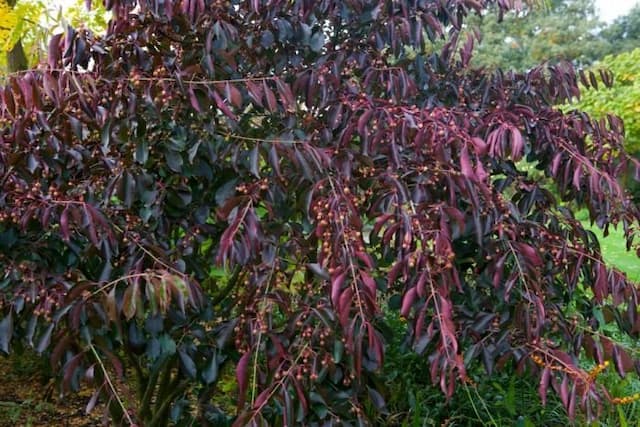

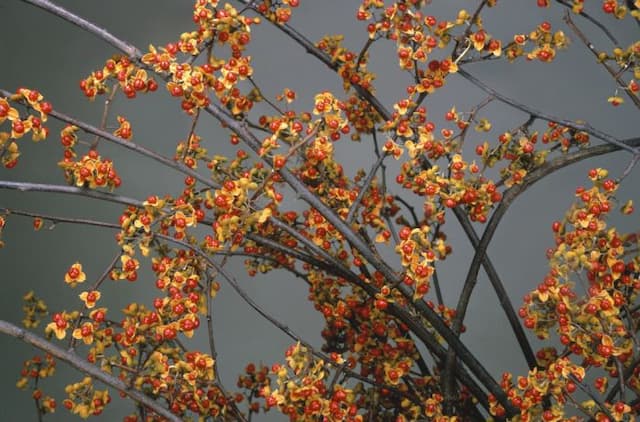
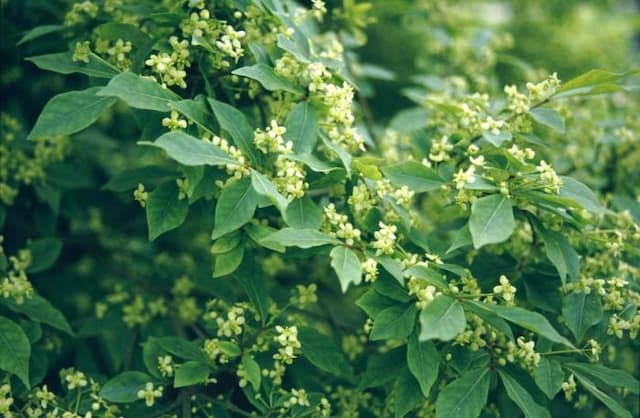
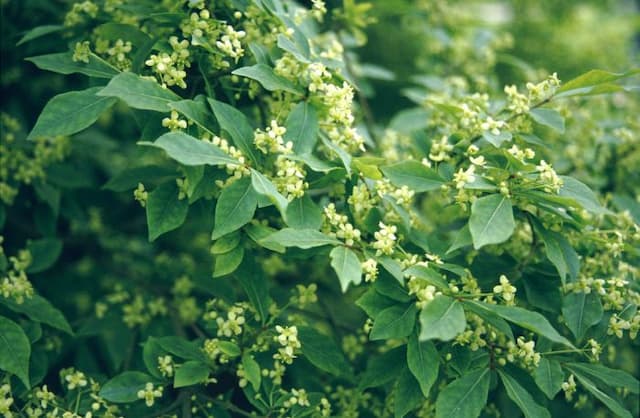

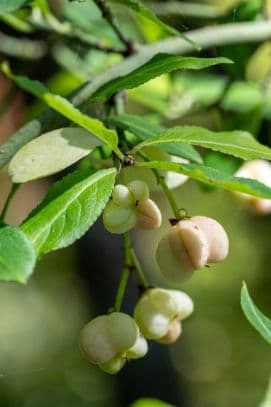
![Spindle [Blondy]](/_next/image?url=https%3A%2F%2Fplants-admin.emdemapps.com%2Fimages%2Fplants%2F%2Fimages%2F604b642f54add.png&w=640&q=75)